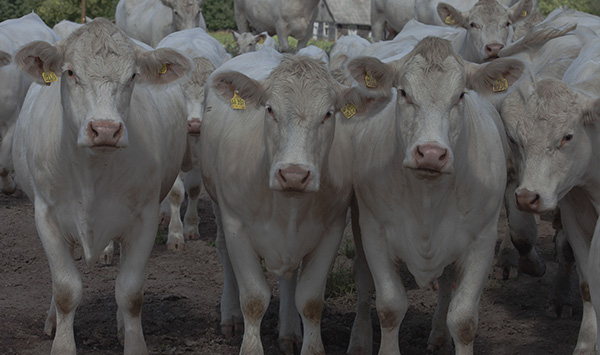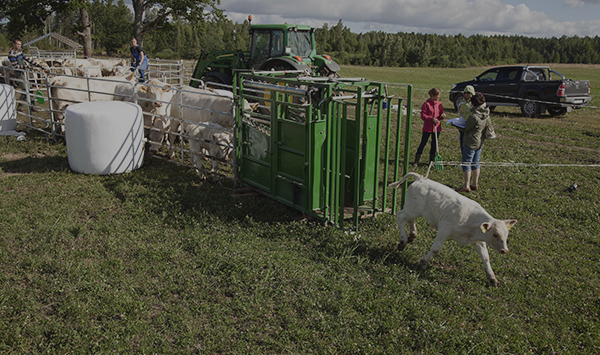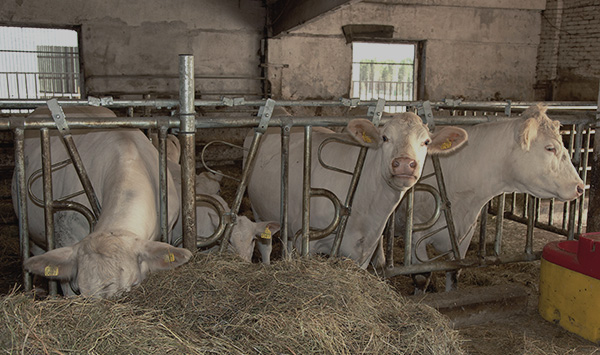The number of beef cattle is rapidly increasing in the cattle farms of Latvia. In recent years farms which create and rear suckler cow herds have become very popular. There is a positive trend as the number of suckler cows, farms and cattle within herds is increasing. According to public information provided by the Agricultural Data Centre, as at 1 January 2014 the number of herds consisting of beef cattle reached 4324, comprising 48 thousand beef cattle. As at 1 January 2017 this rate had increased up to 8466 herds, comprising 96 thousand beef cattle.
The number of farms under the supervision has increased significantly. In total, 918 herds were supervised in 2014, whereas 1243 herds — in 2016. When starting the business of cattle breeding in Latvia, already historically farmers have selected the Charolais breed for cattle breeding. This is why this breed takes the leading position among herds. According to the information at the disposal of the Agricultural Data Centre, there were 13,651 Charolais cattle in the herds under the supervision in 2014, whereas their number increased to 18 965 cattle in 2016. The cattle have been imported from various countries where there are high-quality pure-bred animals. Lately from Sweden and animals of the Swedish origin have been purchased also from other EU countries where these animals are kept and sold for breeding. This choice is influenced by climate conditions characteristic to Northern Europe, as well as the fact that high quality standards have been set for the cattle of the Charolais breed from Sweden.
Since herds of suckler cows have been created in Latvia quite recently, in order to achieve good results the farming system requires significant improvements by introducing the best practices at farms step-by-step. Therefore, upon setting up trials, problematic issues in the industry are highlighted. One must consider the fact that only 88 calves were born per 100 Charolais suckler cows in 2016. There is no information on separated calves. Calving ease of Charolais suckler cows in Latvia is only at the rate of 88.8 per cent and livestock keepers should seriously examine each individual case of complicated calvings. For instance, 99.5 of 100 calves born in 2014 were separated from the suckler cows of the Charolais breed.
Veterinarian Olārs Obodņikovs explained the causes of mortality among calves of suckler cows during the seminar organised as part of the Farm Day within the scope of the Herbivorous Project of the Latvian Rural Advisory and Training Centre on 6 October at Lāses AM, SIA in Kuldīga municipality. He pointed out the poor calving process resulting in a lack of oxygen as the main cause of death. This problem is often observed among insufficiently matured heifers giving birth before 24 months of age or among heifers older than 30 months. Weak or overfed heifers are unable to absorb a sufficient amount of micronutrients, i.e., calcium and magnesium because birth passages are covered with fat. It should be noted that the body condition of a suckler cow is determined according to the system of 9 points, the recommended condition after calving is within the range of 5 up to 6.5 points. If mineral substances, e.g., selenium, iodine, zinc, copper are not properly absorbed according to the physiological state of an animal, the uterus might lack the necessary tone in the calving process which consequently could cause further problems. Absorption of other micronutrients important for the functioning of other organs is also vital. The environment where a calf arrives is important too. Very frequently from the warm and sterile environment of the belly of the cow they enter an unprepared environment. It is important to prepare for calvings and to arrange a clean site covered with rich and dry bedding for animals where the cow would have an area which is not less than 10-14 square metres, without any conditions of stress. In order to avoid premature labour, it is necessary to provide oneself with equipment and the possibility to contact a veterinarian, if necessary.
Despite increase in the number of pure-bred beef cattle, there are not so many farms which are able to offer high-quality animals for breeding. The practice in Europe shows that of all the herds consisting of suckler cows, about 20 per cent should be bred as germinal products, but currently such farms in Latvia are less.
Therefore, the Latvian Rural Advisory and Training Centre set up a trial within the scope of the Herbivorous Project the purpose of which is to compare the descendants of breeding animals of the meat breed at Lāses AM, SIA in Kuldīga municipality, Rumba parish. The farm started the business of cattle breeding five years ago and it has been awarded the status of pure-bred animal breeding farm. The farm is working in accordance with organic farming standards. Currently there are 138 pure-bred suckler cows, 6 pure-bred bulls and more than 100 suckler cows of the Charolais breed. In total there are 328 pure-bred animals in the farm. Lāses AM, SIA manages 422 ha of land suitable for agricultural use, whereof 55 ha are covered with permanent grassland and 325 ha — with temporary grass. The goal of the farm is to create an excellent core of breeding animals in order to obtain high-quality and productive animals — breeding animals with excellent live-weight increase indicators among their descendants, excellent exterior traits which conform to the breed, docile temperament, high fertility rates and most importantly — easy calvings. Dace Meldere, who is in charge of the livestock sector at the farm, firmly believes that high-quality genetics, excellent animal management and a balanced diet are essential for good results. The result cannot be achieved if any of the mentioned preconditions is not fulfilled.
In total 54 calves born to pure-bred Charolais of various age in the period from April 2017 to June 2017 were analysed in the trial. They are the descendants of three pure-bred Charolais bulls born in Sweden. Calves were weighed after birth on day 15-40 (15 May and 20 June) and on day 78-110 (2 August and 31 August). Suckler cows were weighed on 11 August 2016 (during pregnancy) and after calving. Such data as the information recorded in the database of the Agricultural Data Centre, the results of linear scoring of the exterior traits of sires and suckler cows, the age of suckler cows at first calving and when the calves are born, live-weight of calves (kg) at birth, adjusted live-weight at the age of 30 days, adjusted live-weight at the age of 90 days, live-weight gain per 24 hours from the date of birth up to the age of 30 and 90 days, and from day 30 to day 90 were subject to analysis.
Live-weight of calves included in the trial on average is 52.6 kg, the average live-weight of heifers is 51 kg and of bulls — 54.2 kg. In 2014, average live-weight indicators at birth in Sweden were 49 kg for bulls and 46 kg for heifers.
Suckler cows included in the trial had their first calving at the age of 24.7 up to 25.8 months which is economically viable. The average live-weight of suckler cows both before and after calvings differed significantly depending on the calving time, but it complied with the criteria set forth to the Charolais breed of the Swedish line. The live-weight of calves at birth was affected both by gender and lactation of the mother. The highest milk productivity was recorded for cows with longer lactation history. The live-weight of the descendants of various sires did not differ significantly. The descendants of three different sires were included in the trial. Moderately close connection was observed between the live-weight of calves at birth and live-weight of calves at the age of 30 days.
Anita Siliņa,
Head of Livestock Competence Centre of the Latvian Rural Advisory and Training Centre
Source: http://new.llkc.lv/lv/nozares/lopkopiba/zviedru-linijas-sarole-vaislinieku-ieguve-un-izvertejums.


